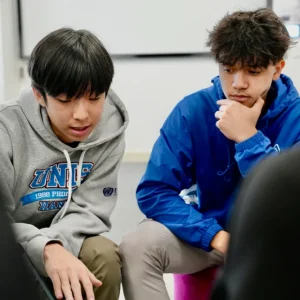Critical thinking represents the capacity for logical, rational, and creative cognition, notably affording individuals, particularly children, the means to address challenges, render reasonable choices and communicate with efficacy, which are crucial for academic achievement and lifelong learning.
To support your children’s development in these areas, we will provide 12 enjoyable activities customised for various age groups, enhancing cognitive growth while nurturing your connection with them in this article.
Critical Thinking Activities for Children (Ages 3-6)
During these pivotal early years, children are buzzing with questions, eager to soak in knowledge about the world around them. This phase is an opportune time to nurture their curiosity and lay the foundation for logical thinking. To harness their boundless energy and direct it towards productive learning, we have curated a list of activities designed to stimulate their minds:
1. Sorting and Matching
By grouping toys or household items based on distinctive attributes like colour, size, shape, or purpose, children learn to recognise patterns and categories. This activity enhances observational skills, vocabulary, and computational thinking for kids when they explain their groupings.
2. Puzzle Play
Puzzles are practical tools for brain development, challenging children to think critically, recognise patterns, and cultivate spatial awareness while refining their problem-solving skills and patience. Whether simple wooden pieces or intricate jigsaws, they are playful yet beneficial.
3. Memory Matching
Memory games are critical thinking games for kids, those are excellent ways to enhance a child’s retention abilities. Through activities where they’re tasked with matching similar cards, children practice concentration and sharpen their recall capabilities while having a blast.
4. Story Cubes
Imagine a set of dice, each side bearing a different image or word. When rolled, these cubes prompt kids to craft unique stories. It encourages them to think on their feet, stretch their imaginations, and craft coherent narratives, thus bridging the gap between creativity and logical thinking.
5. Nature Exploration
The great outdoors is nature’s classroom. By taking children on explorative walks, be it in a bustling park or a quiet woodland, they get to observe and question the intricacies of the world around them. They’ll learn about different species, the changing seasons, and the basics of our ecosystem.
6. Creative Art
Doodling, painting, or crafting allows kids to express their feelings, thoughts, and observations visually. Beyond motor skills development, art activities foster a child’s ability to conceptualise ideas, promoting both imaginative thinking and meaningful expression.
7. Building with Blocks
Blocks, whether wooden sets or magnetic tiles, offer children a tangible way to understand spatial relationships and structural balance. As they stack, arrange, and construct, they unknowingly learn the basics of design, architecture, and physics.
Incorporating these activities into their daily routine promises fun-filled hours and ensures that these young minds are well-equipped with critical thinking skills that will benefit them for years.

Critical Thinking Activities for Children (Age 7-11)
As kids mature, so do their cognitive abilities. Their brains undergo significant development when they navigate through the middle years of their elementary education. This period becomes crucial to introduce them to activities that challenge and refine their growing analytical skills.

Here’s an expanded dive into activities tailored for this age group:
1. Sudoku Challenges
Sudoku, a popular number puzzle, requires children to place digits in a way that each column, row, and subsection contains all numbers from 1 to 9. By wrestling with this puzzle, kids sharpen their problem-solving skills, enhance pattern recognition, and develop a methodical approach to challenges while navigating defined constraints.
2. Decoding Riddles
Riddles are more than just fun; they’re brain teasers. They often present information in metaphors or play on words, compelling children to think outside the box. By decoding riddles, children expand their vocabulary, improve linguistic skills, and learn the art of looking at problems from multiple perspectives.
3. Critical Reading
Deep, analytical reading goes beyond merely understanding the story’s plot. It involves examining characters’ motivations, the consequences of their actions, and the underlying themes. By discussing these deeper layers, children enhance their ability to understand complex emotions, fostering empathy and the skill to evaluate narratives critically.
4. Strategic Board Games
Board games like chess or “Settlers of Catan” are more than just pastimes. They demand planning, strategy, and adaptability. These games teach kids to anticipate opponents’ moves, devise long-term strategies, and learn the invaluable skill of adapting to unexpected challenges. Plus, they learn to accept defeat gracefully and understand that mistakes are just stepping stones to improvement.
5. Tackling Logic Puzzles
Logic puzzles, be they grid puzzles, nonograms, or others, compel children to use deductive reasoning. These puzzles provide statements or clues that must be pieced together to arrive at a conclusion. Such exercises amplify a child’s ability to process information, make connections, and derive logical outcomes.
6. Engaging in Mini Debates
Mini debates are structured discussions where children can present their viewpoints on a given topic. By debating, kids learn to articulate their thoughts clearly and the importance of listening to others, understanding different perspectives, and revising their views when presented with compelling arguments.
7. Developing Writing Proficiency
Motivating children to engage in writing activities such as crafting stories, composing essays, or maintaining journals provides a valuable outlet for them to shape their ideas and articulate their feelings. Regular writing exercises help children organise their ideas, enrich their vocabulary, and ensure their thoughts flow logically. It’s an art that intertwines creativity with structured thinking.
Incorporating these enriched activities into the daily routine of upper elementary kids ensures that they are not just passively consuming information but actively engaging with, analysing, and making sense of the world around them.
Frequently Asked Questions When Applying Critical Thinking Activities for Children

Introducing critical thinking to kids raises several questions; let’s delve into some common ones.
At what age can children develop critical thinking skills?
Children begin laying the foundation for critical thinking skills almost as soon as they start interacting with their surroundings. Even as infants, they observe, react, and learn from their environment. As toddlers grow, they begin to develop connections in their minds and tend to ask an endless stream of ‘why’ questions. So, it’s never too early to start; from infancy onwards, every age bracket presents opportunities to enhance critical thinking.
What challenges arise in implementing critical thinking activities for children?
When introducing critical thinking exercises, a few obstacles might appear, such as wavering attention spans, lack of immediate interest, or initial resistance. The key is to tailor the activity to the child’s interests and developmental stage. It’s essential to strike a balance between challenging them and ensuring the activity remains enjoyable. Continuous encouragement and constructive feedback can also help maintain their enthusiasm.
How can I tell if my child is thinking critically?
A critically thinking child will often display certain behaviours. They might ask in-depth, insightful questions instead of just surface-level ones. They’ll be keen on understanding the ‘how’ and ‘why’ behind various phenomena rather than just accepting information at face value. Additionally, they might make predictions based on past experiences, draw parallels between seemingly unrelated things, or approach problems with a systematic methodology.
Can critical thinking be overemphasised or misapplied?
While it’s beneficial to hone a child’s critical thinking skills, balancing it with emotional understanding and compassion is equally crucial. Overemphasis on pure logic sometimes overshadows the importance of empathy, intuition, and emotional intelligence. Therefore, while promoting critical thinking, it also nurtures emotional awareness, ensuring well-rounded cognitive and emotional growth.
How do I handle a child who becomes overly sceptical or argumentative?
If a child is excessively questioning or tends to argue a lot, it’s vital to guide them toward constructive scepticism. Teach them the importance of open-mindedness and the value of understanding multiple perspectives. You must encourage them to back their arguments with evidence and reason and highlight the significance of listening to others. Reinforcing a mindset that values continuous learning and adaptability can transform their scepticism into a productive trait.
Remember, introducing critical thinking is a journey, not a destination. As with all skills, it evolves and deepens over time with consistent practice and guidance.

Wrapping Up
At UNIS Hanoi, we believe in empowering critical thinking activities for kids through structured skills for academic success and thoughtful living. We focus on self-regulation activities in elementary students. To invest in your child’s future, consider our IB Programmes. Join the UNIS Hanoi community and watch your child thrive!
Author Profile

- UNIS Hanoi is ever-evolving, but one thing that remains is our passion to nurture and equip students to be agents of change for a better world.
Latest entries
 Calendar, News and Publications1 Oct 2025Student Voice and Choice: Benefits & 6 Best Practices
Calendar, News and Publications1 Oct 2025Student Voice and Choice: Benefits & 6 Best Practices Calendar, News and Publications22 Sep 2025Stress Management Techniques for Students: 8 Proven Methods
Calendar, News and Publications22 Sep 2025Stress Management Techniques for Students: 8 Proven Methods Calendar, News and Publications21 Sep 2025What is an Inclusive Learning Environment? A Parent’s Guide
Calendar, News and Publications21 Sep 2025What is an Inclusive Learning Environment? A Parent’s Guide Calendar, News and Publications21 Sep 20258 Game-Changing Innovative Teaching Strategies
Calendar, News and Publications21 Sep 20258 Game-Changing Innovative Teaching Strategies